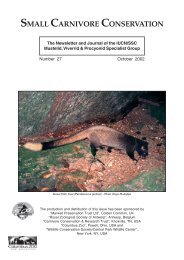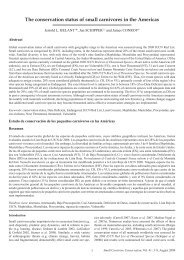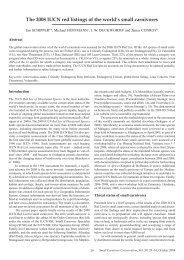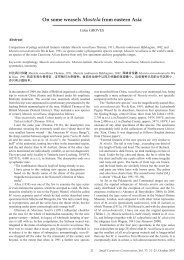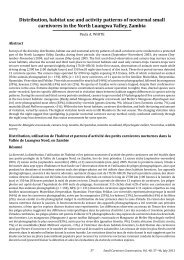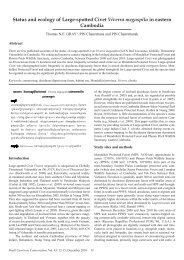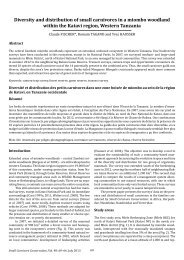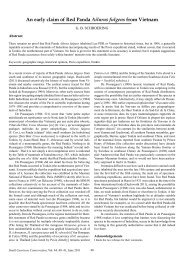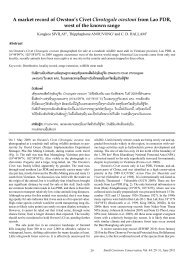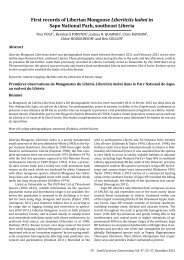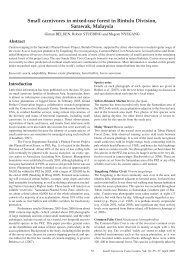Records of Siberian Weasel Mustela sibirica and Yellow-bellied ...
Records of Siberian Weasel Mustela sibirica and Yellow-bellied ...
Records of Siberian Weasel Mustela sibirica and Yellow-bellied ...
Create successful ePaper yourself
Turn your PDF publications into a flip-book with our unique Google optimized e-Paper software.
<strong>Records</strong> <strong>of</strong> <strong>Siberian</strong> <strong>Weasel</strong> <strong>Mustela</strong> <strong>sibirica</strong> <strong>and</strong> <strong>Yellow</strong>-<strong>bellied</strong> <strong>Weasel</strong> M.kathiah from Makalu–Barun National Park, NepalAbstractYadav GHIMIREY * <strong>and</strong> Raju ACHARYATwo species from family Mustelidae rarely recorded in Nepal, <strong>Siberian</strong> <strong>Weasel</strong> <strong>Mustela</strong> <strong>sibirica</strong> <strong>and</strong> <strong>Yellow</strong>-<strong>bellied</strong> <strong>Weasel</strong> M.kathiah, were recorded for the first time in the Makalu–Barun National Park in eastern Nepal during a field survey in 2009–2010. This is probably the first photograph or video record <strong>of</strong> each species in the country.Keywords: camera-trapping, Data Deficient, Least Concern, rhododendronIntroduction<strong>Mustela</strong> is the largest genus in the family Mustelidae, treatedby different authors as containing 14–17 species (Corbet 1978,Corbet & Hill 1980, 1992, Abramov 2000, Macdonald 2001,Wozencraft 2005). Five species, namely Stoat (‘Ermine’ inNorth America) M. erminea, <strong>Siberian</strong> <strong>Weasel</strong> M. <strong>sibirica</strong>, <strong>Yellow</strong>-<strong>bellied</strong><strong>Weasel</strong> M. kathiah, Mountain <strong>Weasel</strong> M. altaica <strong>and</strong>Stripe-backed <strong>Weasel</strong> M. strigidorsa have been recorded fromNepal (Baral & Shah 2008), although Abramov et al. (2008)considered that there were no acceptable records <strong>of</strong> Stripebacked<strong>Weasel</strong> from the country. This paper discusses the firstrecords <strong>of</strong> <strong>Siberian</strong> <strong>Weasel</strong> <strong>and</strong> <strong>Yellow</strong>-<strong>bellied</strong> <strong>Weasel</strong> from theMakalu–Barun National Park in eastern Nepal. Both speciesare poorly known in the country (Jnawali et al. 2011). Amongthe carnivores in Nepal, weasels are the most neglected as faras scientific studies are concerned. There have been no studiesexclusively targeted to weasels in the country, a situation typicalin South <strong>and</strong> South-east Asia.Camera-trapping was the primary method during a fieldsurvey in 2009–2010, with sign surveys also conducted. Twentyonebody-heat sensor camera-traps were placed on trails.Northern Clouded Leopard Ne<strong>of</strong>elis nebulosa was the main targetspecies, so camera-traps were mounted on trees at a height<strong>of</strong> 30–60 cm (Ghimirey et al. 2012). The units were operatedfor the full 24 hour cycle except for those cameras (two units)used in movie mode (for only 20 days in total): these ran indaylight only, because there was no light back-up for the night.Lures or baits were not used during most <strong>of</strong> the survey, butdried meat was used for a week at one site where apparent<strong>Yellow</strong>-throated Marten Martes flavigula faeces were recorded.Locations are given to the datum <strong>of</strong> WGS84.Observations<strong>Siberian</strong> <strong>Weasel</strong> <strong>and</strong> <strong>Yellow</strong>-<strong>bellied</strong> <strong>Weasel</strong> were cameratrappedonce each, in 1,184 trap-nights (Fig. 1). Both recordswere made with the two cameras in movie mode, during daylight,with no precise time recorded.A <strong>Siberian</strong> <strong>Weasel</strong> was camera-trapped on 15 November2009 inside Makalu–Barun NP at 27°48'20.58"N,87°15'51.72"E at a recorded altitude <strong>of</strong> 3,183 m. The moviewas taken in subalpine grassl<strong>and</strong> with scattered rhododendronSurvey area <strong>and</strong> methodsMakalu–Barun NP covers 1,500 km², with 830 km² <strong>of</strong> bufferzone where about 40,000 subsistence agriculturalists resideunder the remit <strong>of</strong> 12 Village Development Committees (VDCs;Zomer et al. 2001). Average annual precipitation is 4,000 mm.This protected area exhibits a high diversity <strong>of</strong> vegetation types:tropical Sal Shorea robusta forest below 1,000 m altitude; subtropicalSchima–Castanopsis forests between 1,000 <strong>and</strong> 2,000m; temperate broadleaf forests between 2,000 <strong>and</strong> 3,000 m;subalpine conifer forest with st<strong>and</strong>s <strong>of</strong> Himalayan Birch Betulautilis <strong>and</strong> Rhododendron between 3,000 <strong>and</strong> 4,000 m; <strong>and</strong> alpinepastures above 4,000 m with juniper Juniperus, aromatic herbs<strong>and</strong> dwarf rhododendron Rhododendron (Zomer et al. 2001).Fig. 1. Makalu–Barun National Park, Nepal, with camera-trap locations <strong>of</strong><strong>Siberian</strong> <strong>Weasel</strong> <strong>Mustela</strong> <strong>sibirica</strong> <strong>and</strong> <strong>Yellow</strong>-<strong>bellied</strong> <strong>Weasel</strong> M. kathiah.65 Small Carnivore Conservation, Vol. 47: 65–66, December 2012
Ghimirey & Acharyatrees (locally called ‘kurlingo’; a white-flowered species). Wealso recorded a <strong>Yellow</strong>-throated Marten pair at the same logwhere the weasel was captured. Pocock (1941) said that <strong>Siberian</strong><strong>Weasel</strong> occurs only above 3,000 m in Nepal, in accordwith this record. The area is within the Saldim valley, a strictnature reserve. The area is undisturbed during most <strong>of</strong> the year,but some herders keep their cattle <strong>and</strong> sheep there in summer<strong>and</strong> monsoon. Hunting <strong>and</strong> trapping, to which weasels may bevulnerable, are frequent at these times. The video allows nostills <strong>of</strong> printable quality, but was shared with several people,including A. V. Abramov, who concurred with identification as<strong>Siberian</strong> <strong>Weasel</strong>. The animal shows a small black tip to the tail.Although this species’s tail is <strong>of</strong>ten said to lack a dark tip, A. V.Abramov (in litt. 2012) confirmed that such a tip (smaller thanon M. erminea) is common in the populations in South Asia <strong>and</strong>China. The video also shows the species’s characteristic tailshape:bushy, thinning to the end.A <strong>Yellow</strong>-<strong>bellied</strong> <strong>Weasel</strong> was camera-trapped on 9 June2010, at 27°27'23.04"N, 86°59'54.72"E at a recorded elevation<strong>of</strong> 2,457 m, in the Sisuwa river valley southwest <strong>of</strong> thepark, in the buffer zone. The habitat is dominated by oaksQuercus. During summer <strong>and</strong> monsoon seasons, the area isdisturbed by herders <strong>and</strong> their livestock; trapping <strong>and</strong> hunting<strong>of</strong> the local wildlife is then rampant. People from the nearestvillages, Tenchhong <strong>and</strong> Hoyongla, also frequently visit thearea to fetch Himalayacalamus (a thin bamboo locally knownas malingay nigalo) for their household requirements, whichaffects the habitat <strong>of</strong> these weasels. This video also gave noprintable stills, but the identification was validated by othersincluding Kashmira Kakati <strong>and</strong> A. V. Abramov.DiscussionJnawali et al. (2011) assessed <strong>Siberian</strong> <strong>Weasel</strong> as nationallyLeast Concern under Red List criteria. However, there are s<strong>of</strong>ew data for status assessment <strong>of</strong> this species in the countrythat it should arguably be considered Data Deficient. <strong>Yellow</strong><strong>bellied</strong><strong>Weasel</strong>’s national status is assessed as Data Deficient(Jnawali et al. 2011). These may be the first video or photograph<strong>of</strong> either species taken in Nepal. Effects <strong>of</strong> potentialthreats in Nepal to these species are unknown.Both these species <strong>of</strong> weasel are categorised as LeastConcern globally by The IUCN Red List <strong>of</strong> Threatened Species(IUCN 2011). There is growing evidence that the tropicalAsian weasels are not well surveyed by camera-traps (e.g.Duckworth et al. 2006, Abramov et al. 2008, Supparatvikornet al. in press), so these species may be more common in Nepalthan is suggested by the rarity in camera-trap results. Conservationawareness at local levels in Nepal regarding weasels isextremely low. Most local people do not even know that suchspecies exist in the area. This, coupled with the lack <strong>of</strong> scientificstudies <strong>of</strong> the species, are serious problems for conservation<strong>of</strong> weasels in Nepal. The smaller carnivore species likeweasels that are rarely recorded by typical survey methods,perhaps because <strong>of</strong> their small build <strong>and</strong> skulking behaviour,should be high priority for specific scientific investigation.AcknowledgementsWe would like to acknowledge the Critical Ecosystem PartnershipFund grants in eastern Himalayas/WWF Nepal <strong>and</strong> Panthera Cor-poration for their financial support, <strong>and</strong> Idea Wild for providingequipment (three camera-traps) for field work. Friends <strong>of</strong> Natureprovided logistic support during the field work. Dept <strong>of</strong> NationalParks <strong>and</strong> Wildlife Conservation, Nepal, provided the necessary permits<strong>and</strong> support. Kashmira Kakati needs special mentioning here forencouraging us before <strong>and</strong> during field work. Last but not the least,we would like to acknowledge S. Khaling, A. P. Sherpa, B. V. Dahal,B. Ghimire <strong>and</strong> R. Lama for their constant cooperation, encouragement<strong>and</strong> logistics support.ReferencesAbramov, A. V. 2000. A taxonomic review <strong>of</strong> the genus <strong>Mustela</strong> (Mammalia,Carnivora). Zoosystematica Rossica 8: 357–364.Abramov, A. V., Duckworth, J. W., Wang Y. X. & Roberton, S. I. 2008.The Stripe-backed <strong>Weasel</strong> <strong>Mustela</strong> strigidorsa: taxonomy, ecology,distribution <strong>and</strong> status. Mammal Review 38: 247–266.Baral, H. S. & Shah, K. B. 2008. Wild mammals <strong>of</strong> Nepal. HimalayanNature, Kathm<strong>and</strong>u, Nepal.Corbet, G. B. 1978. The mammals <strong>of</strong> the Palaearctic Region: a taxonomicreview. British Museum (Natural History), London, U.K.Corbet, G. B. & Hill, J. E. 1980. A world list <strong>of</strong> mammalian species. BritishMuseum (Natural History) <strong>and</strong> Comstock Publishing Associates(Cornell University Press), London, U.K. <strong>and</strong> Ithaca, U.S.A.Corbet, G. B. & Hill, J. E. 1992. The mammals <strong>of</strong> the Indomalayan region:a systematic review. Natural History Museum Publications<strong>and</strong> Oxford University Press, Oxford, U.K.Duckworth, J. W., Lee, B. P. Y.-H., Meijaard, E. & Meiri, S. 2006. TheMalay <strong>Weasel</strong> <strong>Mustela</strong> nudipes: distribution, natural history <strong>and</strong>a global conservation status review. Small Carnivore Conservation34&35: 2–21.Ghimirey, Y., Ghimire, B., Pal, P., Koirala, V., Acharya, R., Dahal, B. V. &Appel, A. 2012. Status <strong>of</strong> felids in Makalu–Barun National Park,Nepal. Cat News 56: 23–27.IUCN 2011. IUCN Red List <strong>of</strong> Threatened Species. Version 2011.2.. Downloaded on 23 April 2012.Jnawali, S.R., Baral, H.S., Lee, S., Acharya, K.P., Upadhyay, G.P., P<strong>and</strong>ey,M., Shrestha, R., Joshi, D., Lamichhane, B.R., Griffiths, J., Khatiwada,A. & Amin, R. (compilers) 2011. The status <strong>of</strong> Nepal mammals:the National Red List Series. Department <strong>of</strong> National Parks <strong>and</strong>Wildlife Conservation, Kathm<strong>and</strong>u, Nepal.Macdonald, D. 2001. The encyclopedia <strong>of</strong> mammals. Barnes & Noble/Andromeda Oxford, Abingdon, U.K.Pocock, R. I. 1941. The fauna <strong>of</strong> British India, including Ceylon <strong>and</strong>Burma. Mammalia, 2nd edn, vol. II. Taylor <strong>and</strong> Francis, London,U.K.Supparatvikorn, S., Sutasha, K., Sirisumpun, T., Kunthawong, N., Chutipong,W. & Duckworth, J. W. in press. Discovery <strong>of</strong> the <strong>Yellow</strong>-<strong>bellied</strong><strong>Weasel</strong> <strong>Mustela</strong> kathiah in Thail<strong>and</strong>. Natural History Bulletin<strong>of</strong> the Siam Society.Wozencraft, W. C. 2005. Order Carnivora. Pp. 532–628 in Wilson, D.E. & Reeder, D. M. (eds) Mammalian species <strong>of</strong> the world. A taxonomic<strong>and</strong> geographic reference, 3rd edn. Johns Hopkins UniversityPress, Baltimore, U.S.A.Zomer, R. J., Ustin, S. L. & Carpenter, C. C. 2001. L<strong>and</strong> cover changealong tropical <strong>and</strong> subtropical riparian corridors within theMakalu–Barun National Park <strong>and</strong> Conservation Area, Nepal.Mountain Research <strong>and</strong> Development 21: 175–183.Friends <strong>of</strong> Nature, P.O. Box 23491, Kathm<strong>and</strong>u, Nepal.*Email: pantherapardusypg@gmail.comSmall Carnivore Conservation, Vol. 47, December 201266



